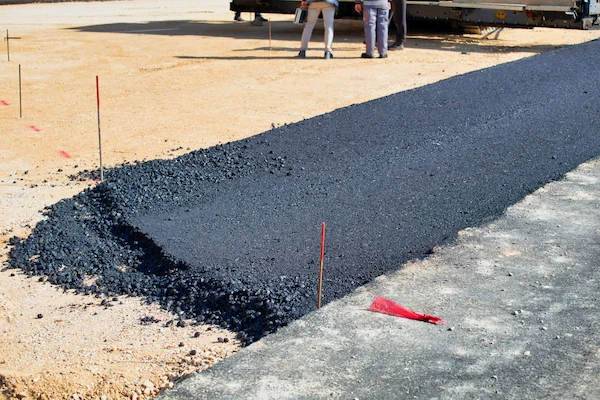When we think about roads, we often take for granted the materials that lie beneath our tires. Yet, the choice of pavement material impacts the durability, maintenance needs, and cost of our road networks.
This article ventures beneath the surface to explore the different types of pavement. We will explore the role each type plays in creating a robust, reliable infrastructure.
Understanding the different pavement materials helps us appreciate their silent work. They carry the weight of our civilization, both literally and metaphorically. Read on.
Types of Pavement
Pavement is broadly defined as the surface layer of a road, parking lot, or other paved area. It provides vehicles with a smooth driving surface. It serves two primary functions:
- supporting vehicle traffic
- protecting the underlying layers from water and weather damage
While there are many kinds of pavement materials, they can be categorized into two main pavement types:
Flexible Pavement
Flexible pavement, also known as asphalt pavement, is a versatile and durable road construction method. It consists of many layers, each serving a specific purpose.
At the very top, we have the surface or wearing course. It acts as the main protective layer against traffic loads while ensuring a smooth driving experience.
Just underneath, we find various layers such as:
- base courses
- frost protection layers
- subbase courses
All of which work together to provide the necessary structural support for the pavement.
These pavements use bituminous materials that can withstand high levels of stress and strain without getting damaged. This flexibility is especially helpful in places where the soil can change because of temperature or other factors. As a result, flexible pavements are commonly employed in the construction of the following:
- low-speed roads
- parking lots
- driveways
Flexible pavements are a reliable and affordable solution for safe and durable roads. They can adapt to changes and handle heavy loads.
Rigid Pavement
As the name suggests, rigid pavement is stiff and inflexible compared to its flexible counterpart. It is constructed from a concrete slab that rests on a compacted base course and subgrade.
Rigid pavement is different from flexible pavement. It cannot bend under traffic loads. Instead, it spreads the weight over a bigger area.
This makes it stronger and more durable. This makes it an ideal choice for high-speed roads. Such as highways and interstates, where heavy vehicles travel at high speeds and exert pressure on the surface.
With its ability to withstand heavy loads and resist cracking, rigid pavements offer a longer lifespan. This helps reduce the need for frequent repairs and makes them a cost-effective choice in the long run. Furthermore, this type of pavement is very sturdy and makes driving smoother, which improves safety and comfort on the road.
Pavement Materials
While flexible and rigid pavements are the two main types, there are numerous materials used to construct them. Each material, which you can find from companies like Travertine Pavers at texastravertine.com, offers unique properties that make it suitable for different applications. Here are a few examples:
Asphalt
Asphalt is a widely used material for flexible pavements because it is very versatile. The material is made by combining chosen aggregates, like:
- sand
- gravel
- bitumen
Asphalt has a special makeup that makes it resistant to water. It is also very durable and flexible, so it can handle tough traffic conditions.
These qualities make it the preferred choice for constructing long-lasting, reliable roads. This ensures safe and smooth transportation for generations to come.
Concrete
Concrete, the primary material used in rigid pavements, is a versatile and robust construction material. Concrete is made by carefully mixing cement, water, and aggregates like crushed stone or gravel. This creates a strong and long-lasting material.
Concrete is more durable and lasts longer than asphalt, making it the preferred choice for high-traffic areas. It can handle heavy loads and perform well for a long time.
Additionally, concrete is highly resistant to oil and chemical spills. This makes it a great choice for industrial roads, where spills are common.
Concrete is essential for modern infrastructure because it is reliable and versatile. It provides a strong foundation for transportation networks. This helps ensure safe and efficient travel for future generations.
Brick
Brick pavement, called brick pavers, has interlocking bricks arranged in different patterns. This type of pavement finds its common applications which add a touch of elegance and charm in:
- pedestrian walkways
- plazas
- patios
Brick pavement looks great and can improve the look of any area. It creates a nice environment. However, brick pavement may not be the best for busy places because of its characteristics.
In addition, regular maintenance is needed to make it last longer and stay strong, which makes it harder to take care of than other road materials. However, many people still choose brick pavement for its timeless beauty and classic appeal when creating outdoor spaces.
Pavers
Pavement pavers, also known as precast concrete blocks or bricks, are manufactured in a wide array of shapes, sizes, and colors. This versatility allows for endless design possibilities, enabling the creation of intricate patterns and artistic motifs on sidewalks, driveways, and patios.
Not only do pavers enhance the aesthetic appeal of outdoor spaces, but they also boast exceptional durability, ensuring long-lasting performance. Additionally, their ease of installation and minimal maintenance requirements make them an increasingly popular choice among homeowners seeking both beauty and practicality in their hardscape designs.
Gravel
Gravel is a widely used material for constructing roadways, driveways, and parking lots. It consists of small stones or rocks that are bound together with either bitumen or cement, creating a durable and stable surface. Gravel pavements offer several advantages, including cost-effectiveness and low maintenance requirements.
However, it is worth noting that due to its granular nature, gravel may not provide the smoothest driving surface compared to other materials. Despite this, gravel remains a popular choice for many applications due to its versatility and affordability.
Learn How to Choose the Right Type of Pavement
Pavement is an essential component of the transportation infrastructure. It provides safe and reliable access for vehicles and pedestrians.
From flexible to rigid pavements, these types of pavement serve a specific purpose and offer unique characteristics that make it suitable for various applications. To understand the pavement materials, we need to appreciate the complex network beneath our feet. It keeps us moving forward every day. So, take a moment to reflect on the pavement beneath your tires and the role it plays in your daily lives.
To keep exploring the world beneath your feet and other topics, read more of our blog posts.
Read Also: The Ultimate Guide To Different Types Of Concrete Finishes







